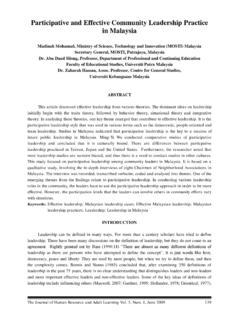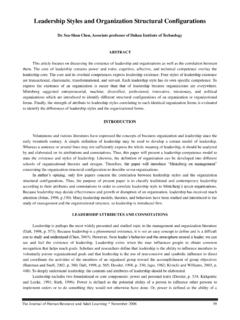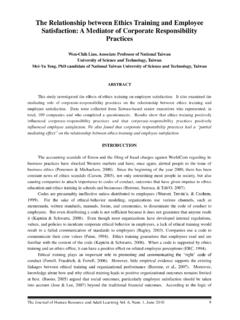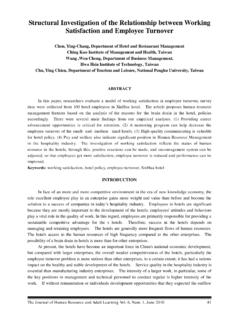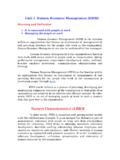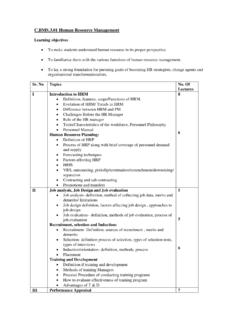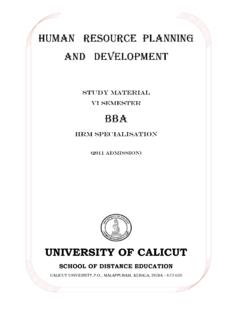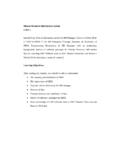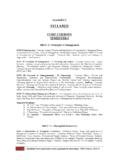Transcription of Human Resource Development in Learning …
1 The Journal of Human Resource and Adult Learning * November 2006 52 Human Resource management Plays a New Role in Learning Organizations Dr. Ping Yu Wang, Associate Professor of Hsuan Chuang University ABSTRACT Needless to say, the performance of Human Resource management (HRM) has a tremendous impact on growth, market/book value, and productivity especially in today s global competitive market. In order to survive in today s business market, many companies have done their best to shift from their old shells to the new ones. Peter M. Senge (1990) devoted a new idea for those who wished to change their traditional business operation systems. The idea was to integrate the applications of the five disciplines of a Learning organization into their companies. However, the processes of transforming are complex.
2 HRM must play a new role in order to help the organization to apply the concepts of Learning organization successfully. LITERATURE REVIEW Definition of Learning organization The phrase " Learning organization " has become popular used nowadays in many different enterprises. It is because most enterprises have shifted from traditional operations to complex and flexible ones. Marsick and Watkins (1994) indicated that " Learning organization " learns continuously and can transform itself. It empowers the people, encourages collaboration and team Learning , promotes open dialogue, and acknowledges the interdependence of individuals, the organization , and the community. McCutchan (1997) noted that the fundamental source of competitive advantage in today s organizations was shifting from resources to knowledge and from relatively stable sources of technological and market advantage to the capacity to create such advantages.
3 Sphr (1999) further explained that Learning organizations are firms that recognize the critical importance of continuous performance-related training and Development and take appropriate action to provide them ( ). Therefore, the key characteristic for the success of an organization is its ability to learn. " Learning organization " was invented in the 1980s to describe organizations that experimented with new ways of conducting business in order to survive in turbulent, highly competitive markets (Senge 1990). According to the core theory of the Learning organization proposed by Peter M. Senge in 1990, there are five disciplines, , Personal mastery , Mental models , Building shared vision , Team Learning and System thinking . The applications of the five disciplines should fall into the following four main categories: communication and openness; inquiry and feedback; adequate time; and mutual respect and support.
4 Characteristics of a Learning organization Personal mastery Peter Senge describes personal mastery is one of the core disciplines needed to build a Learning organization . Since personal mastery applies to individual Learning , organizations cannot learn until their members begin to learn. To start the personal mastery, the organization must define what individual is trying to achieve, and need a true measure of how close one is to the goal. After setting individual goals, critical reflection is significant as people develop personal mastery and continue to expand their ability to create the results they want. McCutchan (1997) stated that through dialogue individuals built shared vision which pulled the organization and it was people toward the goals they truly wanted to achieve. Mental models Kine & Sunders (1993) indicated that a mental model was one's way of looking at the world.
5 It was a framework for the cognitive processes of our mind. In other words, it determined how we think and act. Mental models are the The Journal of Human Resource and Adult Learning * November 2006 53 deeply ingrained assumptions and paradigms that influence how we understand and act in the world (Senge, 1990). Building shared vision Garvin (1993) noted that a shared vision began with the individual, and an individual vision was something that one person held as a truth. In systems thinking that goal is most often a long term goal, something that can be a leading star for the individual. However, to shared visions would be very difficult because it is almost impossible for everyone in organization to have the same goals, and the drawing will probably be interpreted differently by people, but still there is something powerful about the imagery that most people can see.
6 Senge (1990) stressed that when an organization had a shared vision, the driving force for change comes from creative tension. Creative tension is the difference between the shared vision and the current reality. With truly committed members the creative tension will drive the organization toward its goals. Thus, the leader of the organization should share his/her vision with the employees but not to force them to accept it. It s important to encourage others to share their vision. Based on these visions, the organization 's vision should evolve. Team Learning Contributors to The Fifth Discipline Fieldbook declare that team Learning defines as a discipline that starts with "dialogue," the capacity of members of a team to suspend assumptions and enter into a genuine "thinking together.
7 " Team Learning is vital because teams, not individuals, are the fundamental Learning unit in modern organizations. Team Learning is not team building, describing the latter as creating courteous behaviors, improving communication, becoming better able to perform work tasks together, and building strong relationships. (Senge, 1990, p. 355) System thinking Humankind has successfully developed scientific knowledge by adopting an analytical method to understand and to figure out problems. This method involves breaking a problem into components, studying each part in isolation, and then drawing conclusions about the whole. According to Senge, this sort of linear and mechanistic thinking is becoming increasingly ineffective to address modern problems. (Kofman and Senge, 1993, p. 18) This is because, today, most important issues are interrelated in ways that defy linear causation.
8 McCutchan (1997) indicated that systems thinking tied all the other disciplines together and offers a set of tools to understand complex organizational issues. Systems thinking, along with transformative Learning alters the individual's predominant ways of thinking in order for them to understand and manage in a world of increasing inter-dependency. Mastering systems thinking helps them see how their actions have shaped their current reality and that transformation develops the confidence that really can create a new reality in the future (Senge, 1990). Figure1 presents the characteristics that define the Learning organization , and for individuals and group to practice the Characteristics in their organization . Two characteristics are individual; three are group-based. The characteristics listed in Figure1 are concrete cognitive and behavioral tools, as well as specific types of social interaction and structural conditions, that help to improve the qualities of the organizations.
9 The Journal of Human Resource and Adult Learning * November 2006 54 Characteristic Personal mastery - individual Mental models - individual Building shared vision - group Team Learning - group Systems thinking - group Definition The ability to see reality as it exist, and to define what goals are trying to achieve As one's way of looking at the world; the ability to compare reality or personal vision with perceptions The ability of a group to hold shared visions of future with commitments and mutual understandings The capacity of members of a team to suspend assumptions and enter into a genuine "thinking together." The ability in developing scientific knowledge by adopting an analytical method to understand problems. Practice Willing to face limitations and difficulties; ability to deal with change; being responsible to their behavior Being more openness and positive to things and to colleagues; willing to adopt new challenges more effective communication flows; easier to ease the arguments, to build team trust and commitment, and being more cooperative Group self-awareness; Learning for everyone; helping and encouraging others Learning ; enhanced creativity Long-term improvement or change; decreased organizational conflict.
10 Continuous Learning among group members Figure1: Characteristics of a Learning organization and Practices Human Resource management in New Era Sphr (1999) stated that Human Resource management (HRM) is the utilization of Human resources to achieve organizational objectives ( ). Since overall business markets have increased great competitions, HRM gradually appears to be enormous and expanding. Nowadays, the HRM system normally includes five functional areas which are Human Resource planning, recruitment, and selection; Human Resource Development ; compensation and benefits; safety and health; and employee and labor relations (Sphr ,1999). Ever since the 1970s, in the business circle that was already client-oriented and excellence-pursuing, many managers started to break, in large scale, the management pattern featuring the traditional hierarchic system.
